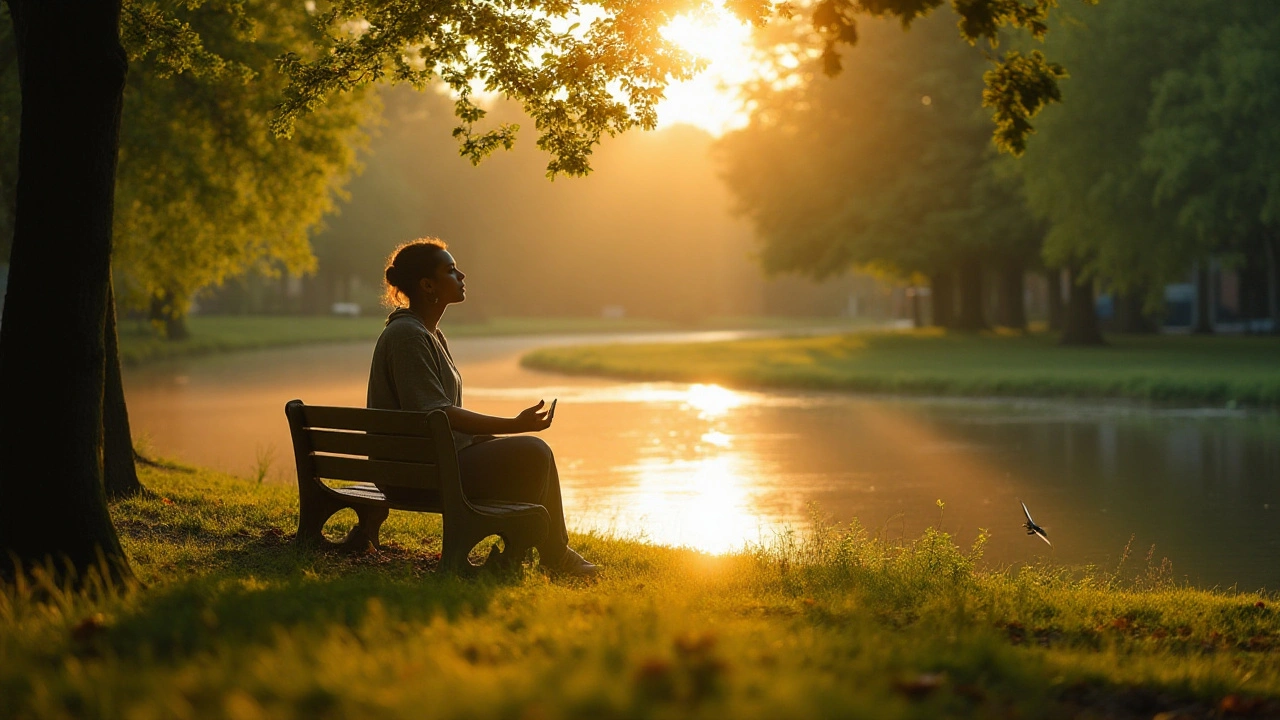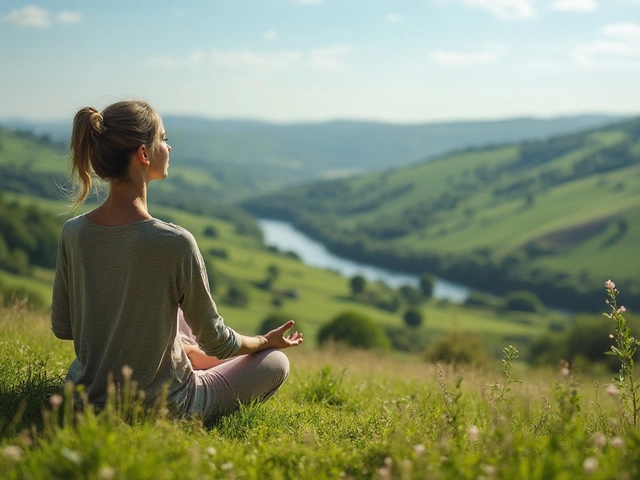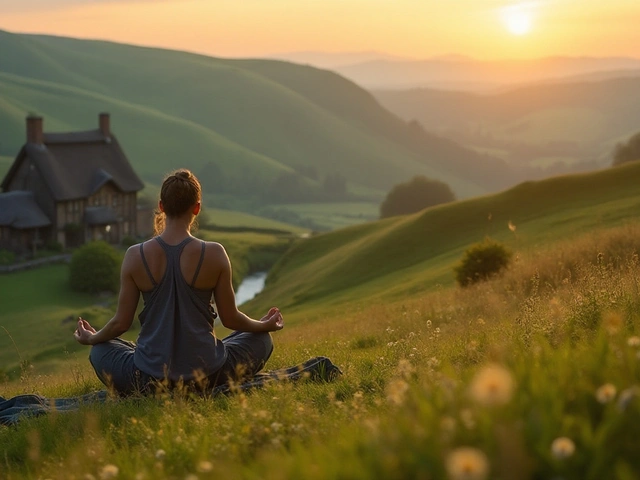Calmness can often be seen as a precious but elusive state in a world bustling with chaos. While it may sometimes appear passive, its role is radically transformative when it comes to building resilience. Truly, calmness is the unsung hero in the face of adversity.
When life's storms are raging, those who harness calmness find themselves standing stronger and ready to adapt. The process of developing resilience begins with learning to manage emotions and stress through calmness. Discovering ways to remain serene can make the journey smoother, no matter the challenges faced.
Embracing calmness doesn’t mean sidestepping life's difficulties, but rather facing them with a grounded sense of peace. By the end of this article, you'll have practical insights and strategies to unlock the potential of calmness in your day-to-day life.
- Understanding Calmness
- The Link Between Calmness and Resilience
- Benefits of Staying Calm
- Tips for Cultivating Calmness
- Incorporating Calmness into Daily Life
- Building Emotional Resilience Through Mindfulness
Understanding Calmness
Calmness is often mistaken for a lack of energy or indifference, but in reality, it is one of the most powerful tools at our disposal. It is more than a state of mental quietness; calmness acts as a carefully constructed shield against the frenzied pace of the world around us. This state allows us to engage with our environment without being overwhelmed by it. By embracing calmness, individuals can experience enhanced emotional clarity, which ultimately aids in better decision making. Those who nurture a calm disposition often find it easier to navigate conflicts and stressful situations without being bogged down by negative emotions or anxiety.
Delving into the realms of ancient wisdom and modern psychology provides us with insights into why calmness is so vital. In ancient philosophies like Buddhism and Stoicism, calmness is seen not merely as an end but a means to perceiving life with greater equanimity. These teachings underscore that maintaining calmness can lead to inner peace. Studies show that people who practice mindfulness and meditation — both of which encourage a state of calm — show less activity in the amygdala, the part of the brain responsible for processing emotions like fear and anxiety. This calm state benefits not just our mental health, but our physical health too, lowering stress-induced ailments.
Calmness functions as a reset button for the mind, offering a sanctuary where one can recharge and reflect. Those who establish routines around achieving calm states—like mindfulness exercises, yoga, or deep-breathing techniques—often report reduced stress and increased creativity in their daily living. A calm mind fosters deeper introspection and a broader perspective, enabling individuals to view challenges not as barriers but as opportunities for growth. In this dynamic, stress becomes not a debilitating foe but a catalyst for harnessing resilience.
"The greatest weapon against stress is our ability to choose one thought over another," famously stated William James, the father of American psychology. This profound insight emphasizes that calmness is deeply connected to the choices we make about which thoughts to cultivate and entertain.
It's essential to realize that true calmness doesn't imply a complete absence of stress or excitement, but rather the capacity to remain grounded amid them. This understanding positions calmness as an active choice and ongoing practice that can significantly enhance resilience. With dedicated effort, individuals can cultivate calmness within various facets of their lives, creating an internal oasis that shields them when external pressures rise. Indeed, the ability to pause and breathe deeply through times of discomfort can transform one’s experience of life’s turbulences.
The Science Behind Calmness
The science supporting calmness as a resilience-enhancing trait is growing. Neuroplasticity, the brain's ability to reorganize itself, plays a crucial role here. It allows new patterns of calmness to be formed even if one is not naturally predisposed to a calm disposition. Endorphins, the body's natural stress-relievers, are released when one engages in calming activities, providing a natural, healthy way to counteract the stresses of daily life. This biological foundation confirms what many ancient teachings have touched upon—that calmness is a learnable, sustainable trait.
In summary, understanding and achieving calmness is not merely about ignoring the chaos but embracing it with a mind fortified by peace. By cultivating calmness, individuals enhance their resilience, allowing them to face life's challenges with newfound strength and perspective. It is through this lens that calmness should be viewed: as the cornerstone upon which a resilient, fulfilled life is built.
The Link Between Calmness and Resilience
In our fast-paced, demanding world, the relation between calmness and resilience finds its roots in the way our minds and bodies respond to stress. When calamity strikes or minor inconveniences unearth frustrations, the ability to remain calm stands as a significant pillar of emotional survival and adaptation. Remaining calm breaks the cycle of stress hormones that can derail our focus and decision-making abilities. It is the difference between reacting instinctively and responding thoughtfully, and it ensures that our emotional and mental health stays on course despite the turbulence.
Dr. Daniel Goleman, a well-regarded psychologist, noted that emotional intelligence—of which calmness is a component—is indispensable when navigating life's challenges. Reflecting on calmness as an asset, he remarked, "Calmness of mind is one of the beautiful jewels of wisdom." Calmness is a form of preparedness, arming individuals with a special sense of clarity and calm that fosters resilience. Stressful situations often trigger the fight-or-flight response, but through calm, the mind retains objectivity, enabling a person to assess their circumstances neutrally and choose the most appropriate course of action.
The physiological benefits of calmness are worth noting, too. Maintaining a serene mindset helps lower blood pressure, reduce heart rate, and decrease cortisol levels, all of which improve mental health resilience. This physical composure translates directly into our emotional well-being, teaching us to handle future setbacks with grace. In this state, the brain is more adept at seeking solutions rather than wallowing in the problem. Studies suggest that people who practice staying calm tend to have a better likelihood of bouncing back from adversity faster than those who easily succumb to stress.
Incorporating methods that enhance calmness offers a dual benefit, fostering not just immediate serenity but long-term resilience. Ancient philosophies and modern science collectively advocate practices like meditation and mindfulness as core tools in cultivating this essential tranquility. Considered daily or even weekly routines, these practices serve as mental exercises to nurture peace, ensuring that when challenges arise, we are ready and composed rather than frazzled and overwhelmed. Truly, calmness is more than just quietude; it is a profound resilience builder, equipping individuals with the strength to adapt and thrive.

Benefits of Staying Calm
In the hustle and bustle of modern life, maintaining a state of calmness can feel like an uphill battle. However, the benefits it offers are profound and worth the effort to cultivate. Beginning with the brain, calmness plays a crucial role in improving cognitive functions. A calm mind is better equipped for critical thinking, problem-solving, and decision-making. This is because when we are calm, our brains are not overwhelmed with stress hormones like cortisol, which hinder our ability to think clearly. When cortisol levels are high, our memory can suffer and creative thinking can be stifled. A relaxed state supports neurogenesis, the process of creating new neurons, which is essential for learning and memory.
Maintaining calmness is also beneficial for our physical health. Chronic stress can lead to significant health problems including heart disease, insomnia, and weakened immune systems. When we practice calmness, our body enters a state of rest and digest, which contrasts with the fight or flight response triggered by stress. In this restful state, blood pressure drops, the heart rate slows, and healing processes in the body are more efficient. A study published in the Journal of Health Psychology found that individuals who practiced regular relaxation techniques had lower rates of illnesses and reported feeling more energized.
Another powerful benefit of staying calm is its effect on interpersonal relationships. When individuals approach interactions with a sense of calm, they are more empathetic, open, and capable of listening actively. This facilitates a deeper understanding and connection between people. A person who remains calm under pressure is often better at resolving conflicts amicably, which strengthens bonds and fosters trust. Dr. Emma Seppälä, a leading expert in the psychology of well-being, stated,
"Calmness as an interpersonal tool can dissolve tensions and lead to more meaningful conversations and collaborations."
Importantly, resilience is fortified through the practice of staying calm. Resilient individuals are not those who never face adversity, but those who can navigate it without being overwhelmed. Calmness gives us the space to process emotions, assess situations objectively, and respond with clarity and intention. This emotional equilibrium allows one to recover from setbacks more swiftly and effectively. Resilient people harness calmness to buffer against stress, not just cope with it, improving mental health in the long run. Data from a robust body of psychological research indicates that calm and resilient individuals reported higher life satisfaction and overall well-being.
The art of staying calm is not solely an individual practice; it sets a ripple effect impacting communities and work environments. Calm individuals influence the atmosphere around them, promoting a culture of patience and thoughtfulness. In workplaces, this can translate to better teamwork, higher morale, and ultimately, improved productivity. The ability to remain composed in demanding situations is valued across professions as it enhances leadership capabilities and decision-making prowess. Initiatives that incorporate mindfulness and stress management in organizations have shown substantial returns in employee satisfaction and reduced absenteeism.
Integrating a sense of calmness into daily routines might seem daunting, yet it starts with simple practices. Breathing exercises, meditation, and nature walks are accessible tools for developing calmness. By embracing these practices with intention, individuals not only enjoy immediate tranquility but also cultivate a reservoir of peace that aids in tumultuous times. Building this muscle of resilience through calmness proves invaluable, fostering a life equipped to face both the mundane and momentous with poise and grace.
Tips for Cultivating Calmness
In our fast-paced world, mastering the art of calmness might seem challenging, but it is certainly achievable with dedication and practice. The first step towards cultivating calmness is recognizing its power in bolstering your resilience. By staying calm, you pave the way for a clearer mind, better decision-making, and a more balanced emotional state. To start, consider integrating mindfulness practices into your daily routine. Mindfulness encompasses the simple act of being present and fully engaged in the current moment without judgment.
Activities such as meditation, yoga, or even mindful breathing can have a profound impact on your state of mind. For instance, dedicating just a few minutes a day to mindful breathing can help in training your brain to return to a state of tranquility even when under stress. Studies show that regularly practicing meditation can lead to significant reductions in stress levels, thereby enhancing resilience over time. In fact, the American Psychological Association highlights that mindfulness-based stress reduction is effective in improving psychological well-being.
Another critical approach is ensuring you maintain a balanced lifestyle. Engaging in regular physical activity releases endorphins, often referred to as nature's mood elevators, which play a significant role in promoting feelings of happiness and contentment. Sleep is equally crucial; ensuring a proper sleeping schedule helps the mind reset and prepare to tackle new challenges with a calm demeanor. Nutrition, too, plays a role—incorporating a diet rich in omega-3 fatty acids and antioxidants can enhance brain function and contribute to a more stable mood. A balanced lifestyle can enhance your body's capacity to recover from stress and adapt to new situations effectively.
It's also important to consider the environment. Surrounding yourself with a calming environment, be it at home or in the workplace, can significantly aid in maintaining calmness. A cluttered space can lead to a cluttered mind, so prioritizing organization and cleanliness in your immediate surroundings can promote a more serene outlook. Additionally, dedicating personal time in nature, even if it's just walking in a park, has been proven to reduce stress and restore peace of mind. Introducing elements like house plants or calming colors to your living space could also contribute to a tranquil setting.
"The greatest weapon against stress is our ability to choose one thought over another," said William James, a renowned philosopher and psychologist. His wisdom reminds us that our perception and mental conditioning can transform our experiences.
Lastly, remember the power of human connection. Having a support system, whether it involves friends, family, or a community group, can provide comfort and perspective. Conversations with empathetic listeners or sharing feelings with those who understand can act as a soothing balm for the soul. Developing calmness doesn't have to be a solitary journey; leveraging social connections can be a significant step in enhancing your resilience. Trust and lean towards people who can guide you through difficult times while keeping you grounded.

Incorporating Calmness into Daily Life
Calmness often seems like a distant ideal in the whirlwind of daily responsibilities and stressors. Yet, with a little strategy and awareness, incorporating calmness into your everyday routine is not only possible but immensely rewarding. One effective method to start is by creating a personal space dedicated to tranquility. This doesn't have to be a grand gesture; it can simply mean finding a corner in your home where you keep a favorite chair, a few houseplants, or a photo that brings peace. Each time you enter this space, let it become a sanctuary where the noise of the outside world fades away, if only for a few moments. Breathing deeply in these spaces helps center your thoughts, providing a moment of respite that can be transformative.
Additionally, the practice of mindfulness is a powerful ally in the quest for calmness. This is about paying attention to the present moment without judgment. Structured routines like mindful walking, where you focus on the sensation of each step and the environment around you, or mindful eating, where you savor each bite and its flavors, can anchor you in moments of stress. Studies have shown that regular mindfulness practice can decrease symptoms of anxiety and depression while also improving overall well-being. It’s about shifting focus from the turmoil to the inner peace that resides within.
"Mindfulness isn't difficult. We just need to remember to do it," as Jon Kabat-Zinn, a mindfulness expert, reminds us.
Regular physical activity, surprisingly, also plays a crucial role in fostering calmness. Physical exercise releases endorphins—chemicals in the brain that act as natural painkillers and mood elevators. Whether it's a calming yoga session or an energizing run, integrating movement into your day creates a rhythm that can instill a state of calm. This isn’t solely about regimented fitness schedules but also about rediscovering joy in movement. A playful dance around the living room or a leisurely stroll in nature can work wonders.
Finally, nurturing a strong connection to nature is invaluable. Engaging with natural environments has been proven to reduce stress and increase feelings of happiness. According to a study published in Frontiers in Psychology, participants who spent at least 120 minutes a week in nature were more likely to report good health and psychological well-being compared to those who didn't. Make it a habit to step outside regularly, feeling the sun on your face, smelling the air after a rainfall, or even cultivating a small garden. These moments create a balance that roots you in calmness.
The key to integrating calmness into daily life is consistency and intention. By making small, regular adjustments, like simplifying your surroundings or adopting a mindful breathing routine, the potential for tranquility in daily life grows exponentially. Choose the strategies that resonate with you and remain open to the evolving nature of your journey toward a more calm and resilient life.
Building Emotional Resilience Through Mindfulness
In today's fast-paced world, finding moments of peace can greatly enhance one's ability to adapt to changing circumstances. Mindfulness, a practice rooted in maintaining a present-focused mindset, empowers individuals by providing tools to foster resilience amid stress and pressure. Emotional resilience involves more than just bouncing back from challenging situations; it’s about growing through adversity and becoming stronger. Mindfulness invites us to embrace every emotion without judgment, allowing us to process experiences with greater clarity.
Engaging in mindfulness techniques boosts emotional resilience by training the mind to remain calm and clear, even under pressure. For example, practices like mindful breathing and meditation teach us to anchor our thoughts in the present, reducing anxiety about the future. Research conducted by Harvard indicates that regular meditation can help decrease stress levels and improve overall emotional health. Mindfulness strengthens our mental agility, making it easier to shift perspectives and adapt to new challenges—a key aspect of resilient behavior.
Introducing mindfulness into daily life can be straightforward. Start with short exercises that require dedication but not overwhelming commitment. Daily sessions of mindful breathing for just five minutes can help establish a regular practice. This small investment pays dividends in increased calmness and resilience over time. Here’s a simple exercise to try: sit comfortably, focus on your breathing, and notice the sensation of your breath entering and leaving your body. Let any thoughts that arise drift away gently, guiding your attention back to your breath.
For those seeking a more structured approach, mindful journaling serves as a powerful means to enhance emotional resilience. By taking a few minutes each day to jot down thoughts and feelings, individuals can gain insight into their emotional landscape. This process offers a space for reflection and aids in understanding patterns in emotional responses. According to a study published in the Journal of Clinical Psychology, those who engage in daily journaling report higher levels of mindfulness and lower levels of emotional distress.
"Mindfulness is a way to befriend ourselves and our experience," states Jon Kabat-Zinn, a pioneer in the field of mindfulness-based stress reduction.
Integrating these practices into a busy life takes intention but is absolutely achievable. Consider setting reminders or scheduling mindfulness sessions, just as one would a meeting or important errand. Over time, mindfulness becomes more than an activity; it evolves into a way of life that supports emotional resilience, offering a foundation on which to build calmness in the face of any storm.






